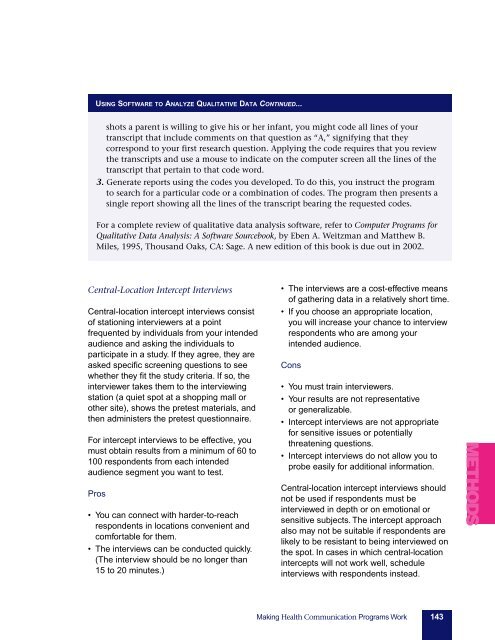pink-book
pink-book
pink-book
You also want an ePaper? Increase the reach of your titles
YUMPU automatically turns print PDFs into web optimized ePapers that Google loves.
USING SOFTWARE TO ANALYZE QUALITATIVE DATA CONTINUED...<br />
shots a parent is willing to give his or her infant, you might code all lines of your<br />
transcript that include comments on that question as “A,” signifying that they<br />
correspond to your first research question. Applying the code requires that you review<br />
the transcripts and use a mouse to indicate on the computer screen all the lines of the<br />
transcript that pertain to that code word.<br />
3. Generate reports using the codes you developed. To do this, you instruct the program<br />
to search for a particular code or a combination of codes. The program then presents a<br />
single report showing all the lines of the transcript bearing the requested codes.<br />
For a complete review of qualitative data analysis software, refer to Computer Programs for<br />
Qualitative Data Analysis: A Software Source<strong>book</strong>, by Eben A. Weitzman and Matthew B.<br />
Miles, 1995, Thousand Oaks, CA: Sage. A new edition of this <strong>book</strong> is due out in 2002.<br />
Central-Location Intercept Interviews<br />
Central-location intercept interviews consist<br />
of stationing interviewers at a point<br />
frequented by individuals from your intended<br />
audience and asking the individuals to<br />
participate in a study. If they agree, they are<br />
asked specific screening questions to see<br />
whether they fit the study criteria. If so, the<br />
interviewer takes them to the interviewing<br />
station (a quiet spot at a shopping mall or<br />
other site), shows the pretest materials, and<br />
then administers the pretest questionnaire.<br />
For intercept interviews to be effective, you<br />
must obtain results from a minimum of 60 to<br />
100 respondents from each intended<br />
audience segment you want to test.<br />
Pros<br />
• You can connect with harder-to-reach<br />
respondents in locations convenient and<br />
comfortable for them.<br />
• The interviews can be conducted quickly.<br />
(The interview should be no longer than<br />
15 to 20 minutes.)<br />
• The interviews are a cost-effective means<br />
of gathering data in a relatively short time.<br />
• If you choose an appropriate location,<br />
you will increase your chance to interview<br />
respondents who are among your<br />
intended audience.<br />
Cons<br />
• You must train interviewers.<br />
• Your results are not representative<br />
or generalizable.<br />
• Intercept interviews are not appropriate<br />
for sensitive issues or potentially<br />
threatening questions.<br />
• Intercept interviews do not allow you to<br />
probe easily for additional information.<br />
Central-location intercept interviews should<br />
not be used if respondents must be<br />
interviewed in depth or on emotional or<br />
sensitive subjects. The intercept approach<br />
also may not be suitable if respondents are<br />
likely to be resistant to being interviewed on<br />
the spot. In cases in which central-location<br />
intercepts will not work well, schedule<br />
interviews with respondents instead.<br />
METHODS<br />
Making Health Communication Programs Work 143


